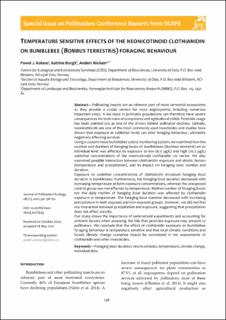| dc.contributor.author | Kolano, Pawel | |
| dc.contributor.author | Borgå, Katrine | |
| dc.contributor.author | Nielsen, Anders | |
| dc.date.accessioned | 2022-01-28T10:36:59Z | |
| dc.date.available | 2022-01-28T10:36:59Z | |
| dc.date.created | 2021-08-09T10:59:49Z | |
| dc.date.issued | 2021-07-09 | |
| dc.identifier.citation | Journal of Pollination Ecology. 2021, 28 138-152. | en_US |
| dc.identifier.issn | 1920-7603 | |
| dc.identifier.uri | https://hdl.handle.net/11250/2933684 | |
| dc.description.abstract | Pollinating insects are an inherent part of most terrestrial ecosystems as they provide a crucial service for most angiosperms, including numerous important crops. A decrease in pollinator populations can therefore have severe consequences for both natural ecosystems and agricultural yields. Pesticide usage has been pointed out as one of the drivers behind pollinator declines. Globally, neonicotinoids are one of the most commonly used insecticides and studies have shown that exposure at sub-lethal levels can alter foraging behaviour, ultimately negatively affecting survival. Using a custom-made bumblebee colony monitoring system, we examined how the number and duration of foraging bouts of bumblebees (Bombus terrestris) on an individual level, and hive growth rate, was affected by exposure to low (6.5 µg/L) and high (10.6 µg/L) sub-lethal concentrations of the neonicotinoid clothianidin via nectar. We also examined possible interaction between clothianidin exposure and abiotic factors (temperature and precipitation), and its impact on foraging bout number and duration. Exposure to sublethal concentrations of clothianidin increased foraging bout duration in bumblebees. Furthermore, the foraging bout duration decreased with increasing temperature at both exposure concentrations, whereas the unexposed control group was not affected by temperature. Neither number of foraging bouts nor the daily rhythm of foraging bout duration was affected by clothianidin exposure or temperature. The foraging bout duration decreased with increasing precipitation in both exposed and non-exposed groups. However, we did not find any interaction between precipitation and exposure, suggesting that precipitation does not affect toxicity. Our study shows the importance of semi-natural experiments and accounting for ambient factors when assessing the risk that pesticide exposure may present to pollinators. We conclude that the effect of clothianidin exposure on bumblebee foraging behaviour is temperature sensitive and that local climatic conditions and future climate change scenarios should be considered in risk assessments of clothianidin and other insecticides. | en_US |
| dc.language.iso | eng | en_US |
| dc.publisher | OJS/PKP | en_US |
| dc.relation.uri | https://www.pollinationecology.org/index.php/jpe/article/view/633 | |
| dc.rights | Navngivelse 4.0 Internasjonal | * |
| dc.rights.uri | http://creativecommons.org/licenses/by/4.0/deed.no | * |
| dc.title | Temperature sensitive effects of the neonicotinoid Clothianidin on bumblebee (Bombus terrestris) foraging behaviour | en_US |
| dc.type | Peer reviewed | en_US |
| dc.type | Journal article | en_US |
| dc.description.version | publishedVersion | en_US |
| dc.rights.holder | Copyright (c) 2021 Pawel Jan Kolano, Malin Røyset Aarønes, Katrine Borgå, Anders Nielsen | en_US |
| dc.source.pagenumber | 138-152 | en_US |
| dc.source.volume | 28 | en_US |
| dc.source.journal | Journal of Pollination Ecology | en_US |
| dc.identifier.doi | 10.26786/1920-7603(2021)633 | |
| dc.identifier.cristin | 1924655 | |
| dc.relation.project | Norges forskningsråd: 268415 | en_US |
| cristin.ispublished | true | |
| cristin.fulltext | original | |
| cristin.qualitycode | 1 | |

